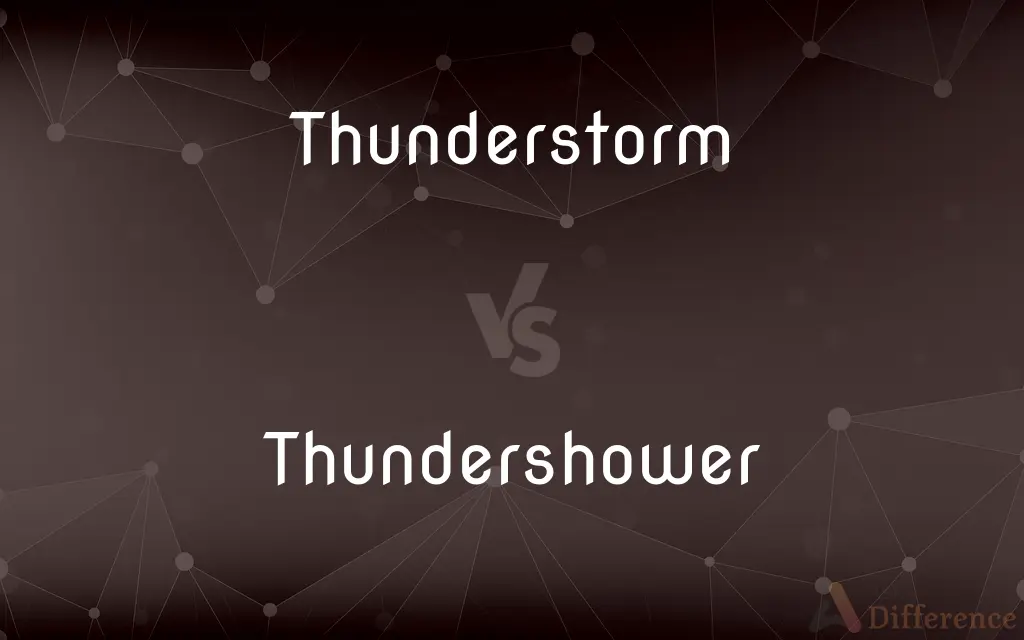Thunderstorm vs. Thundershower — What's the Difference?
By Urooj Arif & Maham Liaqat — Updated on April 16, 2024
A thunderstorm is a weather event characterized by thunder, lightning, and typically heavy rain, while a thundershower implies a lighter, less intense version of a thunderstorm, usually shorter and with less precipitation.

Difference Between Thunderstorm and Thundershower
Table of Contents
ADVERTISEMENT
Key Differences
Thunderstorms are intense weather phenomena involving strong winds, heavy rain, lightning, and thunder, often developing in cumulonimbus clouds. On the other hand, thundershowers are milder and typically result from less severe weather conditions.
Thunderstorms may lead to severe weather effects such as hail, strong winds, and tornadoes, indicating a more robust and hazardous weather system. Whereas, thundershowers are generally associated with brief periods of rain and occasional thunder and lightning, posing less risk.
The formation of a thunderstorm requires specific atmospheric conditions, including high humidity, rising unstable air, and a lifting mechanism (like heat). In contrast, thundershowers can occur with less distinct atmospheric conditions and might not require as strong a lifting mechanism.
Thunderstorms are more likely to cause significant meteorological impacts, such as flash flooding and electrical outages, due to their intensity. Conversely, thundershowers are less likely to lead to severe impacts, typically amounting to light to moderate rainfall.
While thunderstorms are often forecasted with specific warnings due to potential dangers, thundershowers might only be indicated as a chance of rain and thunder in weather predictions, reflecting their less threatening nature.
ADVERTISEMENT
Comparison Chart
Intensity
High, with severe weather elements
Milder, less intense
Duration
Can last longer and cover larger areas
Generally brief and localized
Weather Conditions
Heavy rain, lightning, thunder, possible hail and tornadoes
Light to moderate rain, occasional thunder and lightning
Risks
High risk of flooding, damage from winds, lightning hazards
Lower risk, minimal damage expected
Atmospheric Conditions
Requires unstable air, high humidity, lifting mechanism
Less specific conditions, minimal lifting
Compare with Definitions
Thunderstorm
Known for causing flash floods and severe weather disruptions.
The city prepared for potential flooding due to the expected thunderstorm.
Thundershower
Usually does not lead to severe weather phenomena.
The thundershower passed quickly, with only a small amount of rain.
Thunderstorm
Typically develops in cumulonimbus clouds.
The towering cumulonimbus clouds signaled an approaching thunderstorm.
Thundershower
Less intense and shorter duration than thunderstorms.
The picnic continued after a brief interruption by a thundershower.
Thunderstorm
A storm with thunder and lightning, typically accompanied by heavy rain.
The weather forecast warns of a thunderstorm arriving late in the afternoon.
Thundershower
Often occurs during warmer seasons and can be part of a scattered weather pattern.
Thundershowers are common in late spring and often bring relief from the heat.
Thunderstorm
A meteorological event marked by the presence of lightning and its acoustic effect on the Earth's atmosphere.
The thunderstorm last night caused several power outages.
Thundershower
A light, brief shower accompanied by thunder and sometimes lightning.
A quick thundershower cooled the city yesterday evening.
Thunderstorm
Characterized by strong winds, thunder, lightning, and often hail.
The thunderstorm was so intense that it uprooted trees.
Thundershower
Typically involves less precipitation and wind.
The thundershower brought just enough rain to water the gardens.
Thunderstorm
A thunderstorm, also known as an electrical storm or a lightning storm, is a storm characterized by the presence of lightning and its acoustic effect on the Earth's atmosphere, known as thunder. Relatively weak thunderstorms are sometimes called thundershowers.
Thundershower
A brief rainstorm accompanied by thunder and lightning.
Thunderstorm
A storm with thunder and lightning and typically also heavy rain or hail.
Thundershower
A rain shower accompanied by thunder and lightning.
The thundershower poured down on us as we ran home, but returned to a drizzle after several minutes.
Thunderstorm
A transient, sometimes violent storm of thunder and lightning, often accompanied by rain and sometimes hail.
Thundershower
A shower accompanied with lightning and thunder.
Thunderstorm
A storm consisting of thunder and lightning produced by a cumulonimbus, usually accompanied with heavy rain, wind, and sometimes hail; and in rarer cases sleet, freezing rain, or snow.
Thundershower
A short rainstorm accompanied by thunder and lightning
Thunderstorm
A storm accompanied with lightning and thunder.
Thunderstorm
A storm resulting from strong rising air currents; heavy rain or hail along with thunder and lightning
Common Curiosities
Can thundershowers become thunderstorms?
Thundershowers can escalate into thunderstorms if atmospheric conditions intensify.
How long does a thundershower last?
Thundershowers generally last for a short period, often less than an hour.
Is lightning more common in thunderstorms or thundershowers?
Lightning is more common and intense in thunderstorms compared to thundershowers.
Do thunderstorms occur worldwide?
Thunderstorms can occur almost anywhere in the world but are more common in tropical regions and during warmer months.
What is a thunderstorm?
A thunderstorm is a powerful type of storm featuring thunder, lightning, and often heavy rains and wind.
Can thundershowers affect driving conditions?
Yes, thundershowers can cause wet roads and reduced visibility, affecting driving conditions.
What are the dangers of a thunderstorm?
Thunderstorms can bring severe weather such as hail, strong winds, and lightning, leading to potential damage and danger.
What defines a thundershower?
A thundershower is characterized by being less intense, with lighter rainfall and brief thunder.
What should I do during a thunderstorm?
It’s safest to stay indoors, away from windows, and avoid using electrical appliances.
Are thundershowers predictable?
While thundershowers can be predicted, they are often part of less stable weather patterns and might appear suddenly.
What causes a thunderstorm?
Thunderstorms are caused by the combination of moisture, rapidly rising warm air, and a lifting mechanism.
What type of clouds are associated with thunderstorms?
Cumulonimbus clouds are commonly associated with thunderstorms.
What is the difference in wind speed between thunderstorms and thundershowers?
Thunderstorms typically have higher wind speeds and can cause wind damage, unlike most thundershowers.
How do meteorologists forecast thunderstorms?
Meteorologists use radar, satellite imagery, and atmospheric models to forecast thunderstorms.
Why are thunderstorms more severe than thundershowers?
Thunderstorms have more energy and unstable atmospheric conditions compared to thundershowers.
Share Your Discovery

Previous Comparison
Trading vs. Enterprise
Next Comparison
Fuelled vs. FueledAuthor Spotlight
Written by
Urooj ArifUrooj is a skilled content writer at Ask Difference, known for her exceptional ability to simplify complex topics into engaging and informative content. With a passion for research and a flair for clear, concise writing, she consistently delivers articles that resonate with our diverse audience.
Co-written by
Maham Liaqat















































